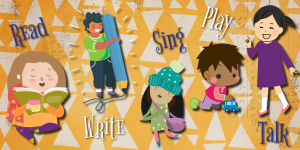
Reading to your child helps them improve their phonological awareness. What is it, why is it important, and what can you do to practice it?
Phonological awareness is when a child is able to distinguish and use speech sounds. It involves words, syllables, rhymes, and alliteration. Alliteration is when two or more words start with the same sound.
Phonological awareness is important because it’s the building blocks of language development and reading. Children with phonological awareness have an easier time learning to read and write. This development is created by hearing others speak and read.
Here are tips and activities you can do with your child to develop phonological awareness.
Babies (0-18 months)
- Read rhyming books to your baby. You don’t have to read the whole book to them.
- Sing songs to them while you are putting them to bed or changing their diapers.
- Talk to your baby. Don’t use baby talk, but talk to them. Just hearing the sounds of you talking will develop their phonological awareness.
Toddlers (18-36 months)
- Read to your toddler at bedtime or when they are tired. Allow your child to move around as you read to them.
- Explain what you are seeing on a walk. Ask your toddler questions.
- Play with your child and communicate what they are doing as they play. “I see you placed the baby on top of the bed.”
- Play a guessing animal game. Describe the animal and make the sounds. Have your child repeat the sound and the animal that it is.
Preschool (3-5 years)
- Play rhyming games. Give a word and ask if they can figure out what rhyming word is missing in your sentence. For example: Her gown was ________ (brown).
- Have your child complete picture sorts. Sort the pictures by their begging sound. Pick two letters to sort. For example: B (pictures of a bear, bat, ball…) P (pictures of a panda, pot, pickle…).
- Play I Spy guessing game. For example: I spy something that starts with the letter /tttt/ sound, is a rectangle, and is watched. (That’s right! Television, television starts with the /tttt/ sound.)
- Play rhyming memory, or rhyming BINGO.
- Sing songs that focus on sounds.
- Point to the words as you are reading a book.
- Label items around the home that are commonly used. Examples would be the door, television, sink, bathroom, and bedroom.
Here are some books to read that focus on rhymes and alliteration:
Here are some songs to sing together
Singable Songs for the Very Young
Look for:
-
-
- Apples and Bananas
- Spider on the Floor
- Down by the Bay
-
-Gabby, Children's Team, Joel D. Valdez Main Library
Resources:
- Bear, D., Invernizzi, M., Templeton, S., & Johnston, F. (2004). Words Their Way: Word Study for Phonics, Vocabulary, and Spelling Instruction. New Jersey: Pearson Merrill Prentice Hall.
- What Is Phonological Awareness? https://www.youtube.com/watch?v=K0G6teawxls
- Phonemic Awareness vs. Phonological Awareness https://www.k12reader.com/phonemic-awareness-vs-phonological-awareness/
- Developing Phonological Awareness Tip Sheet (download PDF) https://redwoods.instructure.com/courses/3055/files/160549/download?wrap=1
- Phonological Activities for Toddlers https://www.hellomotherhood.com/phonological-activities-toddlers-15915.html
- Try this free rhyming game! https://www.themeasuredmom.com/try-free-rhyming-game/
 Read, Write, Talk, Sing, Play!
Read, Write, Talk, Sing, Play!
Reading helps children understand how text works and positions them to increase their language and literacy skills throughout their lives.
Read more about early literacy and how you can make a difference in your child's life.


